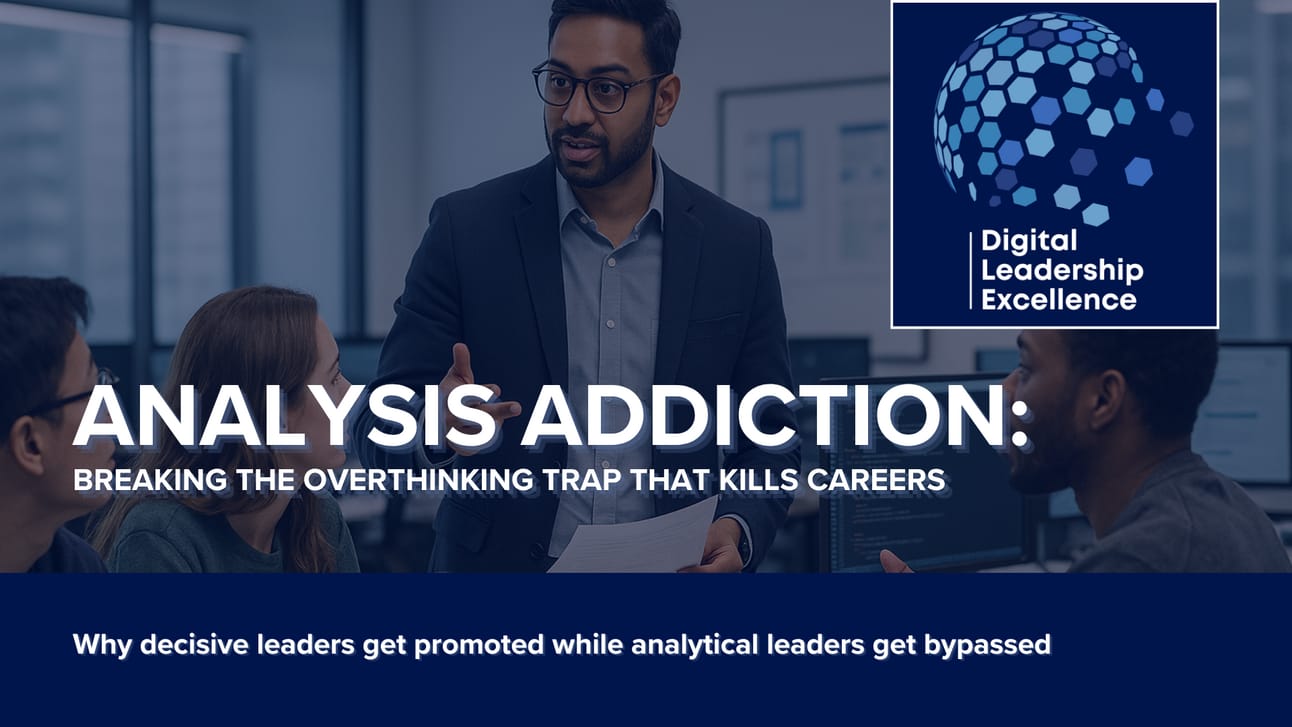Greetings, and welcome to Digital Leadership Excellence — Your trusted weekly guide to excelling in tech leadership, delivering results, and thriving with clarity and purpose. In every issue, we provide insights into winning strategies, growth tactics, and practical solutions, designed to support both current and aspiring technology leaders navigating the ever-evolving digital world.
1.0 Introduction
Let me tell you about the moment everything changed for Sanjib...
He was sitting in his third "final" vendor review meeting, watching his team's eyes glaze over as he presented yet another comparison matrix.
Six months earlier, Sanjib had been the front-runner for CTO. Now? His CEO was openly questioning whether he could "operate at enterprise speed."
The wake-up call came from his most trusted engineer:
"Sanjib, we've analyzed this decision to death. While you've been perfecting spreadsheets, our competitors have already migrated to the cloud and are eating our lunch."
That's when it hit him. His greatest strength - thorough analysis - had become his career's biggest weakness.
Sanjib had developed what I call Analysis Addiction. And it's silently destroying more tech careers than any other leadership blind spot.

2.0 The Addiction That Disguises Itself as Excellence
Here's the insidious thing about Analysis Addiction:
It FEELS like good leadership. It LOOKS like due diligence. Your brain tells you that more data equals better decisions.
But here's the brutal truth: While you're busy analyzing, someone else is busy ADVANCING.
I see this pattern constantly with brilliant tech executives:
The VP who spent 4 months "evaluating" a team restructure while top performers quit waiting for clarity.
The Director who couldn't pull the trigger on strategic initiatives without "additional validation."
The CTO who got replaced because he turned every board decision into a semester-long research project.
They all shared the same fatal flaw: They confused thoroughness with leadership.
3.0 Why Smart People Get Trapped
You didn't develop this addiction overnight. You were REWARDED for it throughout your career.
As an individual contributor, catching edge cases made you valuable. As a senior engineer, thorough testing prevented disasters. As a team lead, careful planning kept projects on track.
But somewhere along the way, a survival mechanism became a career trap.
Now every decision feels like it needs a PhD thesis to support it. Every choice requires consensus from seventeen stakeholders. Every move demands perfect information that simply doesn't exist.

4.0 The Fear Behind the Analysis
Let's get uncomfortable for a moment...
That need for "just one more report"? It's not about data quality.
It's about fear.
Fear of being wrong. Fear of criticism. Fear of taking responsibility for uncertain outcomes.
So you hide behind analysis. You weaponize research. You turn decision-making into an academic exercise.
But here's what you're really doing: You're trading SPEED for the illusion of safety. And in today's business environment, that's career suicide.
5.0 The Hidden Cost of Overthinking
Every day you delay a decision, you're paying a price:
Team Credibility: Your people stop bringing you bold ideas because they know you'll turn them into 90-day feasibility studies.
Executive Presence: Your peers start making decisions without you because they can't wait for your "comprehensive assessment."
Market Position: While you're perfecting your analysis, competitors are gaining ground with "good enough" solutions implemented quickly.
Personal Brand: You become known as the leader who "needs more time to think about it." That's not executive material.

6.0 The Promotion Killer
Here's the hard truth nobody wants to tell you:
Decisive leaders get promoted. Analytical leaders get bypassed.
I've seen this pattern hundreds of times. Two equally qualified candidates for a senior role. One makes quick, confident decisions. The other wants to "study the options more thoroughly."
Guess who gets the job?
The business doesn't care about your analysis process. They care about your ability to move fast and own outcomes.
7.0 Breaking the Addiction: The Velocity Framework
After working with hundreds of addicted analyzers, I've developed a systematic approach to breaking this career-killing pattern.
Stage 1: The Reality Check (15 minutes maximum)
Before you dive into analysis mode, force yourself to answer these questions:
Is this decision reversible or irreversible?
What happens if I decide TODAY versus next month?
Am I seeking information or seeking safety?
Most decisions are reversible. Hire the wrong vendor? Fire them. Pick the wrong approach? Pivot. Choose the wrong tool? Switch.
The cost of delay is almost always higher than the cost of being wrong.
Stage 2: The 70% Rule
Here's a secret that will transform your leadership:
Most decisions become obvious once you have 70% of the relevant information.
That last 30%? It's usually edge cases and hypotheticals that won't change your choice anyway.
Set a hard boundary: When you hit 70% confidence, STOP researching and START deciding.
Stage 3: The Commitment Protocol
Once you decide, the addiction will try to pull you back in.
"Maybe I should reconsider..." "What if I missed something important..." "Perhaps one more stakeholder meeting..."
RESIST THIS URGE.
Commit fully to your decision. Communicate it clearly. Implement it aggressively.
The shocking truth? Wrong decisions implemented quickly often outperform perfect decisions implemented slowly.
Why? Because momentum matters more than precision in the real world.
Sanjib's Comeback: Remember him from the opening? He implemented the Velocity Framework and made the cloud migration decision in 48 hours. His team was shocked. His CEO was impressed. He got the CTO role he'd been chasing.
The pattern is clear: Break the addiction, accelerate your career.
8.0 Speed beats Perfection. Here’s Why:
In today's tech landscape, here's what matters more than perfect analysis:
Learning velocity: Fast decisions create faster feedback loops. You learn what works by doing, not by thinking.
Team confidence: When you make quick calls, your team trusts your leadership. When you overthink, they question your capability.
Market advantage: While you're analyzing, competitors are gaining ground. First-mover advantage beats perfect-mover advantage.
Executive presence: C-suite leaders are paid to make tough calls with incomplete information. If you can't do that, you're not executive material.

9.0 Breakthrough
Starting Monday, I want you to implement these decision timelines:
Routine decisions (hiring, tools, vendors): 24 hours maximum
Strategic decisions (architecture, partnerships, restructuring): 48 hours maximum
Crisis decisions (outages, security breaches, urgent fixes): 2 hours maximum
Sound impossible? That's your addiction talking.
The truth: You already have enough information to make most decisions. You are a professional. You are the expert. You're just afraid to trust yourself.
Your Recovery Plan
Week 1: Track every decision that crosses your desk. Note how long you take and whether additional research actually changed your choice. (Spoiler: It rarely does.)
Week 2: Implement the 70% rule. Stop researching when you hit 70% confidence.
Week 3: Apply the timeline limits. Force yourself to decide within the specified windows.
Week 4: Measure the results. Track team satisfaction, project velocity, and your own stress levels.
You'll be amazed at what happens.
Your team will be more engaged. Your projects will move faster. Your stress will decrease. And most importantly, your leadership brand will transform.
The Decisive Leader Advantage
Here's what nobody tells you about fast decision-making:
It's not about being right all the time. It's about being directional more often than you're wrong.
It's not about having perfect information. It's about maximizing learning velocity through rapid iteration.
It's not about avoiding mistakes. It's about making recoverable mistakes quickly rather than perfect decisions slowly.
The executives who reach the C-suite fastest? They've made MORE wrong decisions than you. But they've also made MORE decisions, period.
Your Analysis Addiction Recovery Challenge
I want you to pick ONE decision you've been sitting on this week.
Apply the Velocity Framework:
15-minute reality check
70% confidence threshold
Commit fully once you decide
Then watch what happens.
Your team will respect your decisiveness. Your peers will notice your new speed. Your boss will see executive potential.
10.0 The Bottom Line
Analysis addiction feels safe, but it's actually the riskiest thing you can do to your career.
In a world that rewards speed and agility, overthinking is a luxury you can't afford.
Stop analyzing. Start LEADING.
Your next promotion is waiting for you to make that decision you've been overthinking.
What choice will you make today instead of next month?

P.S. - If this resonated with you, you're not alone. Most brilliant tech leaders struggle with this transition. The good news? Once you recognize the pattern, it's completely fixable. Share this with another leader who might be stuck in analysis mode.


